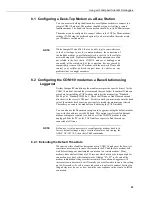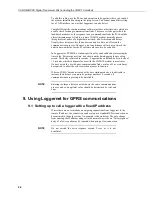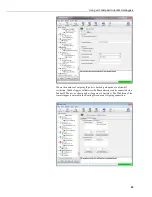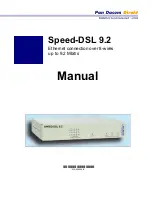
Appendix A. Using the COM110 with the
PIN Security Feature Enabled
It is possible to use the COM110 with Campbell Scientific dataloggers with the COM110’s
PIN (Personal Identification Number) feature enabled. However, this has the following
disadvantages:
•
If the COM110 loses power momentarily, it will not answer further calls until the
datalogger sends the PIN again as part of the normal program sequence. If the
datalogger is programmed to send the PIN only once (leaving the COM110 permanently
switched on), a datalogger reset would be needed to re-enable the system. If a regular
turn on / turn off sequence is used (as described under ‘Controlling the Power
Consumption of the COM110’ in Appendix B), the system will be disabled until the next
sequence occurs.
•
If the COM110 fails to unlock the PIN code, for whatever reason, three times in a row, the
SIM card will be permanently locked. This will require you to contact your airtime service
provider to provide an ‘unlock’ code for the SIM.
A1. Introduction
To operate with the COM110’s PIN feature enabled, the datalogger must transmit
the command to send the PIN to the COM110 after turning on the power. For
CRBasic dataloggers this is simply done by using serial commands to send the
PIN code after the modem is turned on, see the example below. For Edlog
dataloggers this is done using Instruction P97 ‘Initiate Telecommunications’ using
the ‘Generic Modem’ option. This option was added in recent releases of the
CR510, CR10X and CR23X operating systems – from versions 1.06, 1.13 and
1.10 (and later) respectively. If you have one of these dataloggers with an older
operating system, you should download the latest operating system from the
Campbell Scientific website.
Users of older dataloggers, e.g. the 21X, CR10 or CR7, should contact Campbell
Scientific to obtain a copy of a manual written for early versions of the M20T
which describes an alternative, but more complicated, way of sending PIN codes
using special cables and Instruction P98, ‘Send Character’.
A2. CRBasic Program Example
This example can be used on the CR800 series. CR1000 and CR3000 dataloggers.
It uses the standard CRBasic serialopen, serialout and serialclose commands to
send out configuration commands to the modem. The example shows using a slow
sequence to sending the command to unlock the PIN immediately after turning on
the modem.
'CR1000 Series Datalogger
'Example program showing how to turn on/off a GSM modem and disable the PIN code
'Also includes the correct sequence to shutdown the modem cleanly before turning
'off the power.
'The modem control is done in a slow sequence to avoid interference with measurements
'Declare Public Variables
'Example:
Public PTemp, batt_volt
A-1
















































